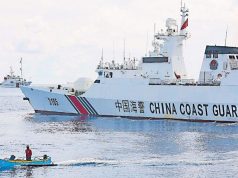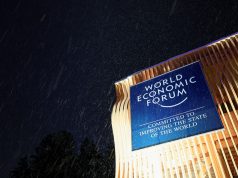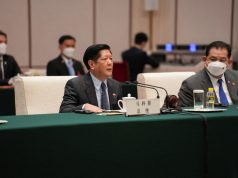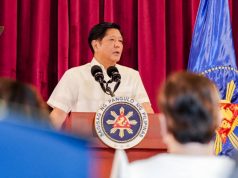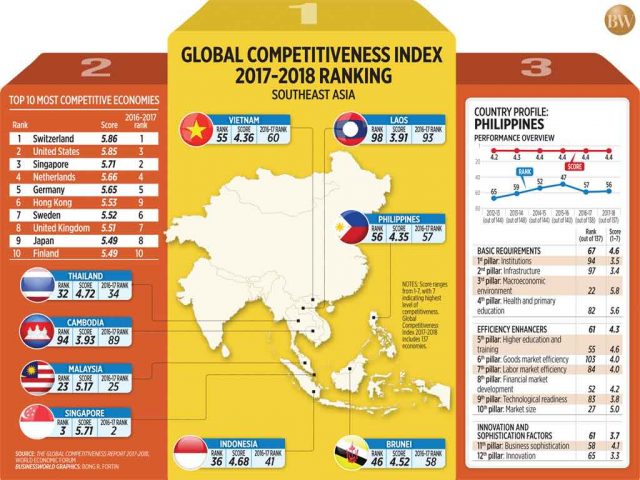
MANILA – The Philippines climbed a rung in the World Economic Forum’s annual competitiveness roster this year even as the country’s score slipped, allowing Vietnam and Brunei Darussalam to jump over it.
The Global Competitiveness Report 2017-2018 released this morning showed the Philippines climbing to 56th spot out of 137 economies in this year’s report from 57th out of 138 in 2016, even as its score slipped to 4.35 — on a 1-7 scale denoting the worst to the best grade — from 2016’s 4.36.
Each economy’s score is calculated across 12 “pillars of competitiveness,” namely: institutions, infrastructure, macroeconomic environment, health and primary education, higher education and training, goods market efficiency, labor market efficiency, financial market development, technological readiness, market size, business sophistication and innovation.
The Forum noted that out of the 17 East Asia and Pacific economies covered by the Global Competitiveness Index, 13 improved their scores — “albeit marginally” — with Indonesia and Brunei Darussalam making the biggest strides. “Only Singapore, the Philippines, Cambodia and Lao People’s Democratic Republic have seen their scores decrease.”
The Forum noted in a separate e-mailed introduction to this year’s report that the fact the Philippines rose in rank even as its overall competitiveness score slipped “slightly” suggested that “other countries’ scores are falling faster.”
The Makati Business Club (MBC), which administered the 2017 World Economic Forum Executive Opinion Survey — a major component of the Global Competitiveness Report — in the Philippines last March, said in a press statement that the country slid to seventh among the nine Southeast Asian states covered by the index from fifth previously.
“With this two-point drop in regional standing, the Philippines is now below Vietnam and Brunei Darussalam, which both made large strides in their respective competitiveness rankings,” MBC noted in its statement.
Sought for comment, John D. Forbes, senior adviser of the American Chamber of Commerce of the Philippines, said he was dissatisfied with the country’s latest performance in the annual report.
“I am disappointed that the Philippines did not improve and I think that we should take a look very carefully at why Vietnam has improved,” Mr. Forbes said in a telephone interview.
Outside the Association of Southeast Asian Nations (ASEAN), two major Asian economies to which the Philippines is frequently compared bared mixed fortunes, with China rising to 27th this year from 28th in 2016 as its score improved to 5.00 from 4.95 and India sliding to 40th from 39th even as its score picked up to 4.59 from 4.52.
INDICATORS
MBC noted that the Philippines made its biggest gains by pillar in “market size” and “labor market efficiency” — each up four rungs to 27th and 84th, respectively — as well as “higher education and training”, up three notches to 55th.
The country still showed its best ranking in terms of “macroeconomic environment”, though here it slid to 20th from 22nd.
In “financial market development”, the Philippines slid four notches down to 52nd spot.
In terms of “market size”, the country climbed four steps to 27th.
In terms of specific indicators, the country bared some of its best positions in “inflation” (first out of 137), “HIV prevalence” (first), “government budget balance” (24th), “malaria incidence” (27th), “business impact of malaria” (26th), “domestic market size index” (27th), and “available airline seat kilometers” (27th).
MBC also noted that out of the five top-ranked competitive advantages, the country slid seven spots from 2016 in terms of “government budget balance” and climbed three steps in terms of “domestic market size”.
The chamber also noted that the country’s ranks also worsened among its worst indicators, including “number of procedures to start a business” (136th out of 137), “tuberculosis incidence” (125th), “burden of Customs procedures” (125th, down four spots from 2016), “business cost of terrorism” (125th, down five notches) and “quality of air transport infrastructure” (124th, down eight steps from last year).
‘WE… NEED TO DO MUCH MORE’
Sought for comment, Guillermo M. Luz, private sector co-chairman of the National Competitiveness Council, said by phone that for the country to climb in rank in the next two years, it has to improve physical infrastructure, primary education, health care and government efficiency.
“It is good to see that we have maintained our overall competitiveness and even moved one notch higher,” MBC quoted its president, Edgar O. Chua, as saying in its statement.
“However, as we implement changes to improve, other countries are doing the same. In fact, Vietnam and Brunei have overtaken us this year,” he noted.
“We therefore need to do much more at a much faster pace. We call on Congress to focus on passing priority bills identified by the business sector especially the Comprehensive Tax Reform Program and not allow itself to be diverted by various political maneuvers like impeachment proceedings.”
MBC Executive Director Peter Angelo V. Perfecto said in the same statement that “the state of Philippine infrastructure is in dire need of attention and action.”
“While the quality of air transport infrastructure was identified as one of the country’s greatest disadvantages, ranking 124th out of 137 countries, the quality of other infrastructure such as roads and ports stand as big disadvantages, as well,” Mr. Perfecto said.
“In fact, we trail behind our ASEAN neighbors in almost all measures of infrastructure. We ranked lowest in ASEAN in terms of ‘quality of overall infrastructure’, in ‘quality of roads’ and in ‘quality of air transport infrastructure.’”
For Mr. Chua, “We cannot advance to the next stage unless our public institutions are strengthened by addressing corruption and we improve our legal and regulatory frameworks.” —with inputs from Anna Gabriela A. Mogato




